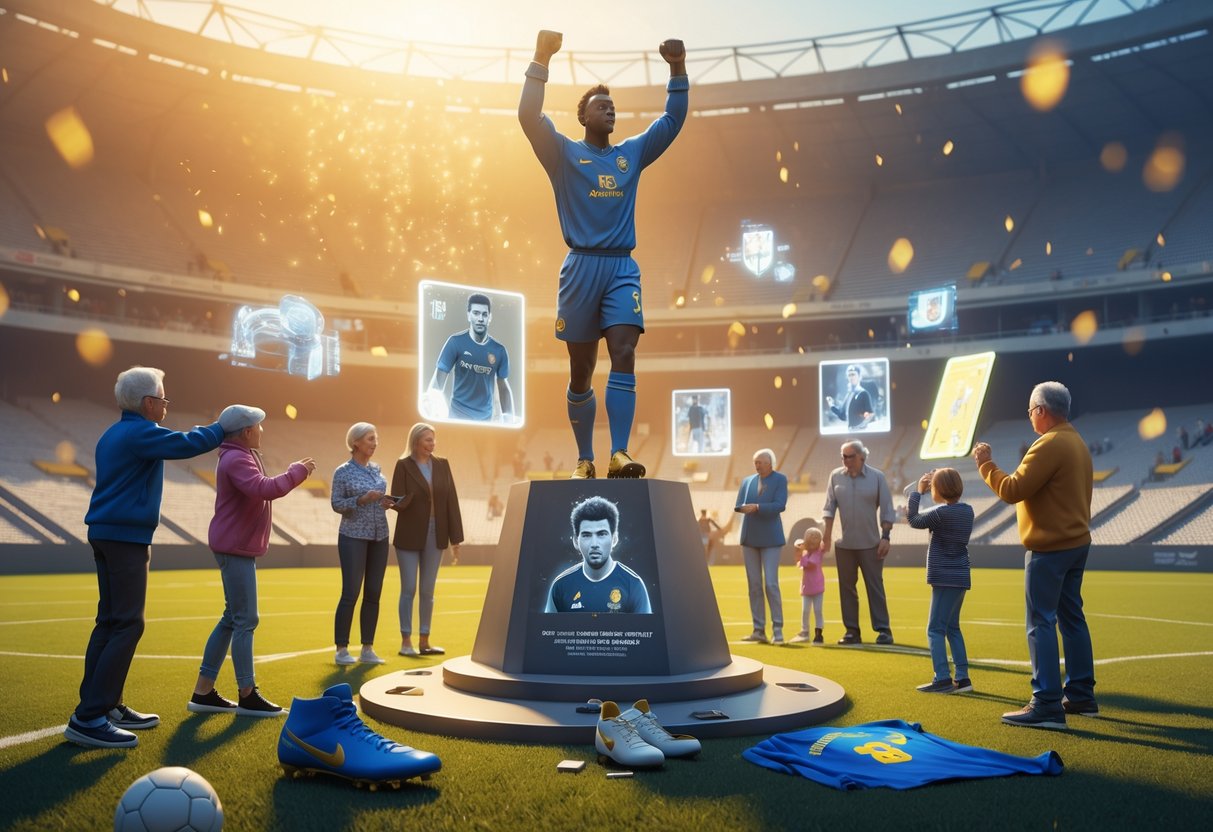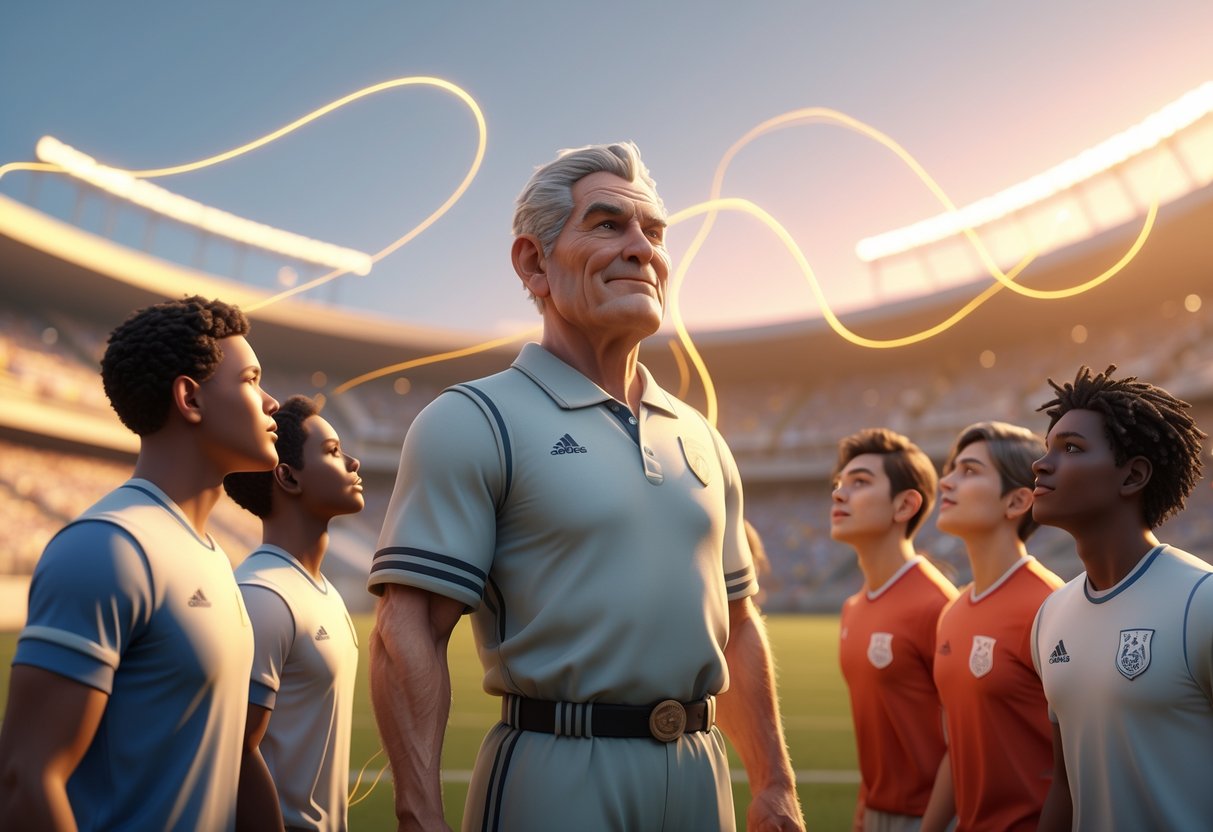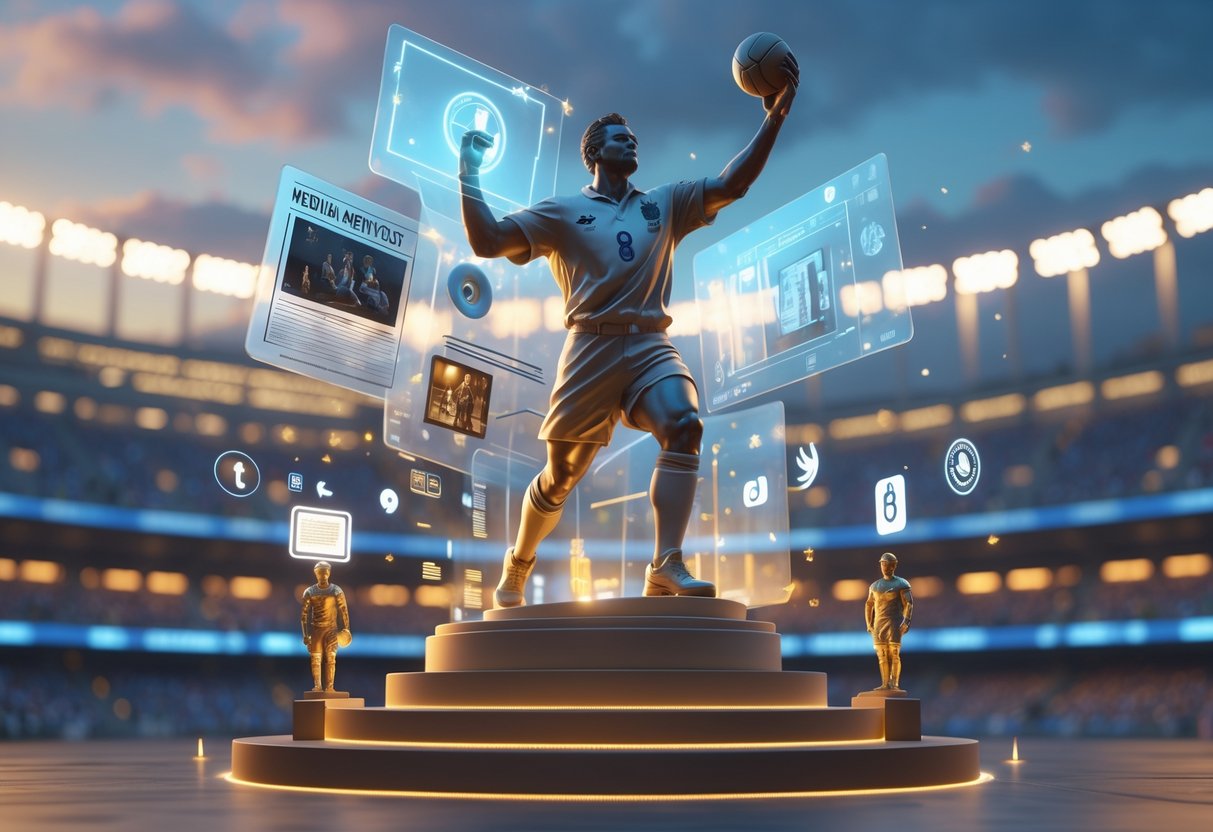Legacy Player Impact: How Sports Legends Shape the Game and Beyond
Updated On: October 24, 2025 by Aaron Connolly
Defining Legacy Player Impact
Legacy player impact is really about the mark athletes leave on their sport—through performance, values, and influence that reach way past their playing days.
We see it in their ongoing contributions to the game, the way they mentor up-and-coming talent, and how they shape the culture long after they’re gone.
Core Principles of Legacy in Sport
Legacy in sport stands on three main pillars. You’ve got performance excellence at the base, but it’s more than just stats or shiny trophies.
The legacies that stick around mix outstanding skill with real sportsmanship. Players who show respect for opponents, officials, and the game itself set standards that outlast their careers.
Character development is the third piece. Players who use their influence wisely, bounce back from setbacks, and keep their integrity under pressure really stand out.
Plenty of basketball players show these qualities. They’re not just racking up points or grabbing rings—they’re lifting the whole sport with their attitude and drive.
All these things together create “generational influence.” Young athletes look up to these legacy players and copy their approach, which keeps good values flowing through the sport.
Lasting Influence on the Game
Legacy players don’t just play the game—they change it. Their impact shows up in tactical tweaks that eventually become the norm.
We see rule changes sparked by standout players. For example, basketball added the three-second rule because of dominant centers, and football updated substitution rules as the sport shifted.
When legacy players bring in new techniques or styles, others follow. That’s how the whole game evolves.
They also leave a mark on the sport’s cultural identity. Their personalities, celebrations, and how they connect with fans just become part of the sport’s DNA.
Kids get hooked on the game after seeing these players excel and play fair. Youth participation often jumps after a truly inspiring run.
Coaches pick up on this too. When former players become coaches, they often use what they learned from the legends they watched or played alongside.
How Impact Is Measured
Measuring legacy player impact isn’t just about stats. We need to look at how they shape the sport and society over time.
Quantitative measures cover long-standing records, awards, and big-time numbers. Still, those only tell half the story.
Qualitative assessment digs into leadership, mentoring rookies, and shaping team culture. Plenty of basketball players guide the next generation, especially when they help rookies find their feet.
| Measurement Category | Examples | Time Frame |
|---|---|---|
| Performance Legacy | Records, championships | 5-50+ years |
| Cultural Impact | Rule changes, playing styles | 10-30 years |
| Social Influence | Community work, advocacy | Ongoing |
Post-retirement contributions matter a lot. If a player goes on to coach, commentate, or lead in their community, their legacy just keeps growing.
We also look at the inspiration factor—how often current stars mention legacy players as their inspiration. That’s a clear link from past greatness to today’s game.
At the end of the day, you’ve got to ask: would the sport look totally different without this player? If so, you’re probably looking at a true legacy player.
On-Field Achievements and Awards
A player’s legacy starts with what they do on the court or field. Achievements during games lay the groundwork for how fans and historians remember them.
Records and Milestones
Breaking records leaves a permanent stamp on basketball history. When someone sets a new scoring record or hits a big milestone, they join the sport’s elite.
Individual records are a big deal in NBA legacy debates. Scoring records, for example, define whole eras.
Career milestones like 30,000 points or 10,000 assists set players apart. Only a handful ever get there.
Single-season records matter too. If a player leads the league in points, rebounds, or three-pointers, it shows dominance—even if just for a year.
Game-specific records—like most points in a game or longest streak without missing a match—become basketball legends in their own right.
These stats don’t just show success. They’re proof of greatness that stands up even decades later.
Championships and Honours
NBA championships are the top prize in pro basketball. Players with several rings usually get a higher spot in legacy talks.
It’s not just about how many titles—they have to lead the team, not just be along for the ride.
NBA Finals MVP awards highlight who shines brightest when it matters most. Those moments cement a player’s reputation under pressure.
Season awards like NBA Rookie of the Year and MVP show immediate or consistent excellence.
All-Star picks and All-NBA teams are yearly nods. If you make ten or more All-Star teams, you’re almost guaranteed a Hall of Fame spot.
Awards like Defensive Player of the Year or Sixth Man show off specific skills. They prove a player’s more than just a scorer.
Game-Changing Performances
The biggest legacy moments usually come in the biggest games. These are the stories fans tell over and over.
Playoff performances really count. Players who step up when elimination’s on the line earn respect that lasts.
Clutch shots in championship games go straight into basketball history. We see these highlights for years.
Battling back from big deficits or playing through injuries adds heart to the stats.
Playing well against the best teams and players proves a player’s quality.
International tournaments like the Olympics offer another stage. Winning there boosts a player’s legacy even more.
Michael Jordan’s Legacy Player Impact
Michael Jordan didn’t just play basketball—he turned it into a global phenomenon. He set records that still define what greatness means today.
His six NBA championships with the Bulls and the Air Jordan brand created a playbook for athlete influence that goes way beyond the court.
Career Highlights and Statistics
Jordan’s career is basically a highlight reel of basketball records. He won six NBA championships and six NBA Finals MVPs with the Bulls between 1991 and 1998.
He picked up five regular season MVPs and made 14 All-Star teams. Jordan’s 30.1 points per game average is still the NBA’s highest.
Key Career Numbers:
- 6 NBA Championships (1991, 1992, 1993, 1996, 1997, 1998)
- 6 NBA Finals MVP awards
- 5 Regular Season MVP awards
- 10 Scoring titles
- NBA Rookie of the Year (1985)
In the playoffs, Jordan took his game up another notch. He averaged 33.4 points per game and always seemed to deliver when it mattered.
The “Flu Game” in the 1997 Finals says it all. Even while sick, he dropped 38 points to lead the Bulls past the Jazz.
Influence on the Chicago Bulls
Jordan took the Bulls from a struggling team to the 1990s’ most dominant force. Before him, the Bulls had never won a title.
He demanded a lot from teammates like Scottie Pippen and Dennis Rodman. His drive pushed everyone to raise their game.
The Bulls’ 72-win season in 1995-96 stood as a record for two decades. That kind of impact shows just how much Jordan elevated the whole franchise.
Bulls Success with Jordan:
- 6 championships in 8 years (1991-1998)
- 72-10 regular season record (1995-96)
- Average of 62 wins per season during championship years
- Sold-out crowds everywhere the Bulls played
When Jordan retired in 1998, the Bulls’ dynasty ended. The team struggled to stay relevant without him, which really drives home how much he mattered.
Global Icon and Cultural Phenomenon
The Air Jordan brand changed sports marketing forever. Nike’s partnership with Jordan built a billion-pound business that still leads the sneaker world.
Jordan became a global icon, not just a basketball star. His influence touched fashion, entertainment, and business—lots of people know his name even if they’ve never watched a game.
Cultural Impact Highlights:
- Air Jordan brand brings in over £3 billion yearly
- Jordan appeared on magazine covers outside of sports
- Inspired athletes across different sports
- Still the subject of documentaries and movies years after retiring
The “Jumpman” logo is everywhere. It’s wild how an athlete’s brand can outlive their playing days and become part of everyday culture.
Jordan’s reach stretched into music, movies, and style. Hip-hop artists dropped his name in lyrics, and his fashion sense set trends well beyond the court.
Influence of Coaches and Mentors
Coaches and mentors play a huge role in shaping legacy players. Their guidance goes way beyond tactics—it’s about character, leadership, and life lessons that stick with players forever.
Role of Dean Smith in Shaping Legacies
Dean Smith changed North Carolina basketball with his coaching style. He focused on building character before worrying about NBA dreams.
Smith’s “Carolina Way” put team unity above individual glory. Players pointed to teammates after assists and learned humility as part of their training.
His impact on NBA careers? Pretty remarkable:
- Coached 96 future pros
- Mentored legends like Michael Jordan and James Worthy
- Built a support network that lasted for decades
Smith stayed in touch with his former players long after they left. He showed up at weddings, helped families, and gave advice during career transitions.
He treated every player as more than just an athlete. He pushed them to do well in school and prepped them for life after basketball. That’s how some of his players became coaches, executives, and leaders themselves.
Basketball Coaching Impact Stories
Basketball coaches can really change lives. Players often call their coaches the people who shaped their values most.
Coaches build legacies in a few key ways:
- Character development – teaching discipline, respect, teamwork
- Crisis support – helping players through injuries and tough times
- Career prep – building non-sport skills for life
- Networks – connecting players with future opportunities
A lot of NBA players say their youth coaches helped them avoid trouble. These mentors offered stability and believed in their potential.
Great coaches keep up with their players for years. They celebrate wins, offer help during rough patches, and keep the mentoring going long after retirement.
Research suggests athletes with strong coaching relationships adjust better after leaving pro sports. That emotional bond and steady support make a big difference.
Cultural and Social Impact

Legacy basketball players have changed society in ways that go way beyond the court. They’ve broken down racial barriers and become cultural ambassadors around the world.
Their influence shows up everywhere—from courtside fashion to how they appear in global media. The changes they sparked keep shaping the world, long after their playing days are over.
Promotion of Racial Equality
Basketball legends have always used their fame to challenge racial injustice and push for equality. Michael Jordan, who once shied away from political statements, stepped up as a strong advocate for change through charitable work and by endorsing equality movements in public.
LeBron James really shows what modern athlete activism looks like. He’s vocal about racial justice and built the “I Promise School” in Akron, offering underserved kids a shot at a better future. Players like Bill Russell, who won 11 championships while facing harsh racism, set the stage for others to speak out.
Key contributions include:
- Creating educational foundations in underserved areas
- Calling out police brutality and racial profiling
- Backing voter registration drives in minority communities
- Using social media platforms to highlight racial issues
These actions inspire millions of fans to get involved in social justice causes. The ripple effect runs deep in communities everywhere.
Influence on Fashion and Media
Basketball stars have totally changed fashion and entertainment, becoming icons who rival movie stars. Michael Jordan’s partnership with Nike brought us Air Jordans, which pulled in over £4 billion in 2022.
Russell Westbrook and LeBron James set global fashion trends. Their pre-game looks spark conversations online and drive clothing sales across different groups.
Media presence includes:
- Acting in blockbuster films (Space Jam, Trainwreck)
- Producing content through their own media companies
- Amassing huge social media followings (LeBron has 159 million Instagram followers)
- Starring in major advertising campaigns
TV shows, music collabs, and brand deals have made these athletes entertainment powerhouses, not just sports figures.
Expansion of the Basketball Brand
Legacy players have turned basketball from a strictly American game into a global phenomenon worth billions. Their tours, endorsements, and media appearances have brought basketball to new audiences around the world.
NBA’s global growth ties directly to star power. Fans in China, Europe, and Africa have embraced basketball because of these players. Giannis Antetokounmpo’s rise boosted the sport in Greece and Africa, while Yao Ming opened up the huge Chinese market.
Global impact measurements:
- NBA games air in 215 countries and territories
- Basketball participation has jumped 40% globally since 2010
- International jersey sales make up 30% of NBA merchandise revenue
- Youth basketball programs now run in over 100 countries
Their reach creates economic opportunities in manufacturing, broadcasting, and tourism. They also inspire young athletes everywhere to chase basketball dreams.
Sportsmanship and Character

Legacy players shape esports’ future through their actions during matches and in public. Their dedication to fair play and integrity sets the tone for entire communities.
Role Modelling On and Off the Court
Legacy players realize their behavior matters far beyond tournament streams. Young gamers pay attention to how they deal with losses, celebrate wins, and treat teammates.
During matches, these players show respect for opponents. They skip the trash talk, give credit for good plays, and keep their cool under pressure. This sets a clear standard for how to act competitively.
Outside competition, legacy players interact positively with their communities. They mentor up-and-coming talent, join charity streams, and use their platforms thoughtfully. Many even create educational content about both game mechanics and good conduct.
You can see the results. Teams with respected leaders communicate better and keep players longer. Tournament organizers notice fewer discipline problems when veteran pros are involved.
Key behaviors that make a difference:
- Shaking hands with opponents after matches
- Owning up to mistakes in public
- Backing up teammates when things get tough
- Responding constructively to fans and critics
Legacy of Fair Play and Integrity
Fair play in esports means following both written rules and unwritten codes. Legacy players stand up for these values, even when shortcuts tempt others.
They report bugs that could help them win, refuse to use glitches, and stay open about their strategies. This honesty builds trust between players, organizations, and fans.
Long-term benefits include:
- More sponsor confidence in the scene
- Better relationships among teams
- Tournaments that people trust
- Higher viewer engagement
Legacy players help shape anti-cheat rules and tournament guidelines. Their advice creates frameworks that protect competitive integrity for the next generation.
Their character becomes part of esports culture. New players learn that real success isn’t just about winning—it’s about earning respect and raising the bar for everyone.
Impact Beyond Playing Days

Many legends make their biggest mark after retiring, through charity and leadership. These efforts often shape communities and future generations more than anything they did on the court.
Philanthropy and Community Involvement
Retired athletes often put their fame and resources into meaningful charitable work. They get that sports gave them a platform—and they want to use it to help others.
Dean Smith, the basketball legend, lived this out. After coaching, he kept fighting for social causes and supporting education.
Common philanthropic activities include:
- Starting youth sports foundations
- Building community centers and facilities
- Funding scholarships
- Addressing social justice problems
A lot of former players focus on their hometowns. They fund after-school programs, mentor at-risk kids, and donate gear to teams that need it.
The impact can snowball. A small youth program might change hundreds of lives. Former athletes bring credibility when they talk about hard work and teamwork.
Transition to Executive and Coaching Roles
Many former players move into leadership after their playing days. Their on-court experience gives them valuable insights for managing teams and developing talent.
Executive positions include:
- General manager
- Director of player development
- Team president
- League commissioner
The transition isn’t always easy. Playing well doesn’t guarantee you’ll succeed in management. They have to pick up business skills, financial know-how, and leadership qualities.
Coaching is another path. Ex-players know the mental and physical grind. They relate to what current players go through.
Some become broadcasters or analysts. Their behind-the-scenes knowledge helps fans understand strategies and player choices. This way, their influence reaches millions.
The best transitions involve learning or mentorship. Former players who invest in education often leave the biggest mark.
Globalisation of Basketball Through Player Legacy

Basketball owes its global reach to legendary players whose impact went way beyond the court. These athletes became cultural ambassadors, using their fame to bring basketball to new countries and inspire young players everywhere.
Popularising Basketball Worldwide
Michael Jordan took basketball global in the 1990s. His charisma and athleticism drew in fans from places where basketball barely existed.
Air Jordan wasn’t just a shoe—it was a movement. It changed sports marketing and became a worldwide phenomenon. Suddenly, kids in Europe, Asia, and Africa wanted to “be like Mike.”
LeBron James took this global expansion even further with social media. He shares workouts and personal stories, making basketball feel accessible to fans everywhere.
Dirk Nowitzki from Germany and Yao Ming from China bridged cultures. They proved that basketball talent comes from all over, not just America.
Key global impact areas:
- Sneaker culture spread
- More youth playing basketball
- Media coverage boom
- New basketball facilities
These trailblazers opened doors for today’s international stars like Giannis Antetokounmpo and Luka Dončić.
NBA’s International Influence
The NBA evolved from an American league into a global stage. International players now make up about 25% of NBA rosters, changing how we see basketball talent.
Early trailblazers like Hakeem Olajuwon and Manu Ginóbili paved the way. They brought new playing styles and made the game more interesting.
European basketball focuses on ball movement and shooting. These tactics became standard in the NBA after international players showed how well they worked.
International NBA impact:
| Region | Notable Players | Cultural Contribution |
|---|---|---|
| Europe | Dirk Nowitzki, Luka Dončić | Shooting precision, team play |
| Asia | Yao Ming | Huge fan base growth |
| Africa | Hakeem Olajuwon, Pascal Siakam | Athletic versatility |
| South America | Manu Ginóbili | Creative playmaking |
Modern international stars use their platforms for good. They tackle global issues, making basketball about more than just the game.
The NBA now runs training academies worldwide, finding and developing talent everywhere.
Building a Lasting Brand

Legacy players build brands that last long after they stop playing. Smart endorsement deals and strong personal branding keep them in the spotlight for years.
Endorsements and Commercial Success
The right endorsements can turn a star into a global icon. Michael Jordan’s Nike deal in 1984 created Air Jordan—and changed athlete endorsements forever.
Smart players pick partners that fit their values, not just the biggest paycheck. They want brands that will stick with them for the long haul.
Key endorsement strategies include:
- Signing long-term deals with equity
- Building real relationships with brands
- Creating signature products that match their style
- Working with brands that reach their fans
The best deals feel authentic. Fans notice when a player actually uses and likes a product. That honesty builds stronger loyalty.
Many legacy players sign deals that last after retirement. These keep their names out there and help fund their next moves.
Personal Branding in Retirement
Retirement doesn’t mean fading away. The best player brands shift into new roles—coaches, commentators, business owners, or community leaders.
How they stay relevant:
- Build a media presence before retiring
- Get good at things besides playing
- Keep up with current players and fans
- Share content that shows off their personality and expertise
Some retired players struggle because they wait too long to plan. The smart ones start their next chapter while still active, testing ideas and building audiences.
Social media keeps them in the mix. Regular posts, behind-the-scenes stories, and expert takes all help.
The most successful retired players become bigger than basketball. They use their fame to tackle social issues or launch businesses. That’s how they leave a mark that lasts.
Legacy in Inspiring Future Generations

Basketball players make a real difference by mentoring young people and running programs that go beyond just teaching skills. They help shape character and life values for the next generation.
Mentoring Young Athletes
Basketball players know just how much one-on-one guidance can shape a career. Plenty of retired stars jump into coaching, eager to share not just technical skills but also those tricky life lessons—like how to handle pressure or keep your work ethic sharp.
Magic Johnson really stands out here. He moved from basketball stardom to entrepreneurship, all while mentoring young athletes in both sports and business. He doesn’t just talk about shooting form; he digs into topics like financial literacy and leadership too.
Direct mentorship programmes can totally change lives. LeBron James Skills Academy and similar camps put young players right next to legends. For a lot of kids, these moments are eye-opening—they see up close what dedication and smart training can do.
Mentors push education just as much as athletic growth. Most basketball players push for academic achievement, knowing a well-rounded person has more options. They keep reminding everyone that sports should be a path for personal growth, not just a competition.
| Mentorship Focus | Key Benefits |
|---|---|
| Technical skills | Improved game performance |
| Life skills | Character development |
| Education | Long-term opportunities |
| Work ethic | Discipline and dedication |
Children’s and Youth Programmes
Grassroots programmes open up basketball to kids in underserved communities. These initiatives work hard to make sure everyone gets a shot, no matter their background.
The LeBron James Family Foundation is a great example of real support for youth. The I PROMISE School in Akron, Ohio gives at-risk children education, meals, and support for their families. It’s a model that goes way beyond typical sports programmes.
Community engagement really drives change that sticks. Michael Jordan’s partnerships help fund youth sports facilities and training across different cities. These investments build infrastructure that will serve communities for years.
NBA Cares leads league-wide projects to support youth development. They partner with legends and local organisations to promote education, health, and wellness. Thousands of young people feel the impact every year.
A lot of these programmes fight for diversity and breaking barriers. The Kobe and Vanessa Bryant Family Foundation opens doors for kids from all backgrounds, letting everyone join in sports and activities. It’s about building inclusive spaces where all can thrive.
Media, Memory, and Honouring Legends

Sports media really shapes how we remember the greats, even long after they’ve stepped off the court. Hall of fame ceremonies and public tributes keep their impact alive.
Hall of Fame Inductions
Hall of Fame ceremonies feel like the ultimate nod to legendary players. These events turn personal milestones into permanent pieces of sports history.
The NBA Hall of Fame in Springfield, Massachusetts is kind of the gold standard. Players have to wait five years after retiring before they’re eligible, which gives people time to fully appreciate their careers.
Key elements of successful hall of fame systems include:
- Clear eligibility criteria
- Peer voting processes
- Annual induction ceremonies
- Permanent museum displays
Most big sports leagues now run their own halls of fame. Former players, coaches, and media members usually handle the selection. This brings in a mix of viewpoints when judging a legacy.
The ceremonies themselves often get pretty emotional. Players give speeches, look back on their journeys, and thank those who helped them along the way. Fans and families remember these moments for years.
Statues and Tribute Events
Physical monuments and special events give communities a way to connect with their sports heroes. These tributes make the legends feel real and present.
Statue unveilings always draw a crowd and plenty of media buzz. The best ones capture iconic moments or poses that really defined a player. Where you put the statue matters—a spot right outside the stadium gets the most attention.
Common tribute formats include:
| Tribute Type | Duration | Cost Range |
|---|---|---|
| Jersey retirement | Permanent | £5,000-£50,000 |
| Stadium naming | 10-20 years | £100,000+ |
| Memorial matches | One-off | £10,000-£100,000 |
| Documentary films | Permanent | £50,000-£500,000 |
Retirement ceremonies let fans say goodbye properly. Teams invite old teammates and even rivals, making for a packed house. The emotional bond between legends and supporters really comes out at these events.
Quick win: Tribute events now often include social media campaigns. Fans everywhere can share memories and messages, so the celebration goes way beyond the arena.
Frequently Asked Questions

Former players shape teams well after retirement by building reputations, influencing culture, and setting performance standards. Their legacy still guides team strategies, morale, and even what fans expect from their favourite squads.
How does a past player’s performance influence the reputation of a sports club?
Past legends build reputations that attract top talent and big sponsors. Teams like Fnatic still benefit from their Counter-Strike legends who took home major titles in the early 2000s.
New players often sign on because of a team’s history of winning. Sponsors love backing teams that have a proven record.
The reputation also keeps fans loyal and boosts merchandise sales. People stick with the teams that made their gaming heroes famous.
In what ways do retired athletes continue to affect the current team’s strategies and morale?
A lot of retired esports pros become coaches or analysts for their old teams. They bring in strategies and mindsets that helped them win.
Former players often mentor the current squad. That keeps team culture and playing style consistent.
When legends drop by training camps, team confidence gets a boost. Players feel more connected to championship traditions when the greats are around.
Can you explain how former outstanding athletes set standards for current players?
Championship players set the bar for what current squads aim for. Teams like Team Liquid still talk about their 2017 Dota 2 International win as the benchmark.
Training routines often copy what past champions did. Current players adopt those practice schedules and prep habits from their legendary predecessors.
New players chase records set by the greats. Trying to break those stats gives squads extra motivation.
What role do past sports icons play in shaping the culture of their respective teams today?
Legendary players lay down team values that last through roster changes. Their work ethic and professionalism become part of the team’s DNA.
Many teams set up mentorship programmes so former stars can guide current players. That way, winning attitudes and mental toughness get passed down.
Past icons often come back for big events or team meetings. Their stories remind everyone what it really takes to succeed.
How do the achievements of previous generations inspire current players in a team?
Trophy cases and achievement walls show current players what’s possible. Seeing those past wins pushes teams to aim higher.
A lot of players grew up watching their team’s legends. Getting to play for the same organisation feels like a dream come true.
When former players succeed financially, it shows current squads what’s possible for their own futures. That inspires even more commitment to team goals.
What is the significance of honouring legendary players for a sports franchise?
When a team runs hall of fame programs or retires jerseys, fans feel a real, lasting connection. These ceremonies spark media buzz and make people care even more about the brand.
Teams that honour their legends often convince former players to stick around as coaches or advisors. That way, the organisation keeps valuable institutional knowledge in-house.
Recognition like this tells current players that the team will remember their achievements. It honestly motivates them to invest in the team’s future.















